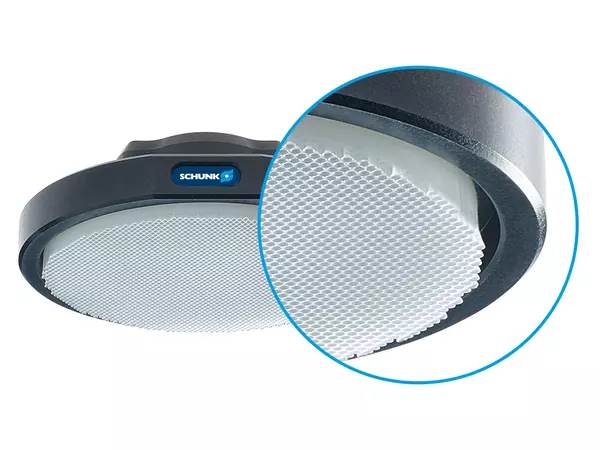


Nature has shown the way and it requires neither glue nor suction power. It allows geckos to race across smooth surfaces in seconds, even holding their entire body weight with just one foot. The secret: millions of tiny hairs on their feet bind to the molecules of the polished surface as they walk.

This creates Van der Waals forces, weak electrodynamic interactions that ensure that the geckos stick to pretty much any surface. SCHUNK has made use of this functional principle from nature for its new ADHESO gripper technology. Plastic pads made of special polymers reproduce the fine hair structure on the adhesive grippers. When gripping, the hairs of the pad press themselves onto the surface of the workpiece. This increases the contact surface and allows the Van der Waals forces to act. This in turn allows the workpiece to be gripped and held without any need for an external energy supply. For users, this offers two decisive advantages. On the one hand, the effort required for installation and commissioning is minimal, and on the other hand, operation of the adhesive gripper saves energy costs, since compressed air, vacuum and electricity are not required at all. The adapter plates with integrated bayonet lock developed by SCHUNK also allow the pads to be changed quickly.

And yet another advantage of the technology: with the help of the adhesive forces, components can be gripped very gently and completely residue-free. Since the new gripping technology works without any mechanical force, it can handle sensitive workpieces such as delicate battery components, glass vials or plastic films very gently. Unlike alternative gripping technologies, they leave no marks on the workpieces. The gripper is also detached from the workpiece without leaving any residue. Philipp Matyssek from ADHESO product sales at SCHUNK explains: "Compared to other adhesive grippers, with ADHESO there is not just one way to release the workpiece from the gripper, but four. Depending on how and where users want to place their workpiece, they can choose between a rotating, tilting or sliding movement as well as pressing." Alternatively, it is also possible to have equipment with an active wiper.
The special surface architecture adheres to a wide variety of materials and objects, making it suitable for a broad range of applications. Feather-light glass fibers, the smallest SMD components, or micromechanical parts can be handled just as well as heavy automotive or mechanical engineering components. This is because the pads can be easily scaled and are always individually tailored to the desired application. "The only important thing is that the workpieces are as smooth as possible," Matyssek explains. "The rougher the surface structure, the lower the gripping force. ADHESO is also well suited for one-sided accessibility, for example when separating paper or other limp workpieces from a storage rack. The technology also delivers good results in microhandling with reproducible positioning accuracies of <0.01 mm.

The gripping technology is particularly suitable in clean environments, such as in a vacuum or in cleanrooms, since dust and dirt affect the gripping force over time. However, full gripping power can be restored by simple cleaning methods, so dirtier environments only affect the maintenance interval. That means it can also be used in conventional industrial environments. Since ADHESO has no moving parts, there are no particle emissions during gripping. ADHESO is particularly well suited for laboratory automation, the medical and pharmaceutical industries, and the electrical industry, since these hygienically sensitive environments also require grippers to work cleanly. Containers, syringes or other medical items made of plastic and glass are also difficult to handle with other technologies due to their often very smooth surfaces. "In the electrical industry, residue-free gripping is critical, especially for wafers" says Matyssek. "Because these must be absolutely pure in order to be able to apply structures on the order of micro- or even nanometers to the silicon." When handling circuit boards, gripping with intermolecular forces offers the advantage that a single adhesive gripper can handle an extremely wide range of different circuit boards. In addition, the technology is also suitable for gripping air-permeable surfaces, such as perforated electronic boards, where conventional gripper technologies reach their limits.

Each standard gripper with ADHESO gripping technology is individually configured and adapted to the customer's requirements. Due to different material characteristics and the individual size adjustment, the adhesive structure can be variably tailored to the workpiece and its surface. Various influencing factors play a role in the design of the adhesive grippers. This includes the weight, material and surface of the workpiece, but also the ambient conditions and the gripping process itself. Application specialists from SCHUNK therefore support users during configuration and offer the possibility of testing the gripping process at SCHUNK in the CoLab, the new application center. This offers users the assurance that the gripping process will work for their workpieces. "The size of the pad is very easily customized and scalable – from a few hundred microns to several meters – and can be made into any geometric shape it needs to grip. This means that ADHESO technology can be used for virtually any component," concludes Matyssek.